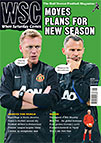 Gary Andrews explains how 3G pitches are becoming a more attractive option for non-League clubs, despite resistance from the FA
Gary Andrews explains how 3G pitches are becoming a more attractive option for non-League clubs, despite resistance from the FA
As the 2012-13 non-League season reached its climax, plenty of clubs will have envied Maidstone United. This wasn’t due to the Stones’ league position – they finished second in the Isthmian League Division One South and were promoted through the play-offs – but instead it was because of their 3G pitch, which registered just one postponement during the season. Non-League is more susceptible to bad weather than higher divisions but even allowing for the inevitable winter postponements, this year’s extended cold snap, snow and rain led to huge fixture pile-ups across the divisions, as reported in WSC 314.
The Northern Premier League opted to extend their season by a week but other divisions stuck to their timetables, leading to a gruelling run-in for some clubs. Guernsey FC, with 17 games to fulfil in April, were forced to play matches on Friday, Saturday and Sunday for three consecutive weeks, while fellow FA Vase semi-finalists Shildon faced a similar backlog and Hampton & Richmond’s pitch problems saw three fixtures a week become the norm.
Amid all the pile-ups, Maidstone stood out. In a season packed with extreme weather, the 3G pitch held its own with the Stones regularly one of only a handful of non-League teams to be playing when weather decimated the fixtures. To those pushing the benefits of artificial turf, the Gallagher Stadium has become the perfect advert. Fixture postponements do not just mean a backlog – there’s loss of matchday revenue to take into account, lower gates and further money to be paid out in getting the pitch up to standard. At a semi-professional level, where budgets are already tight, a problematic pitch can seriously stretch the finances of any team.
Often it’s the lucrative festive fixtures that fall foul of the weather and Southern League South & West team Tiverton Town were one of the hardest hit when the River Exe burst its banks, flooding their pitch with water that nearly reached the crossbar. With five first-team fixtures postponed, the club estimate they lost £4,000 of matchday revenue, even before taking into account
the clean-up bill.
For Matthew Conridge, who stepped down as Tiverton chairman at the end of the season, the benefits of an artificial pitch justify the initial outlay. “I’m a firm believer that 3G pitches are the only way for clubs at and around this level to become viable and sustainable,” he says. “The club receives a pitch which is pretty much weather resistant, meaning no more games being called off. It has a training facility that can be used all year around and it has a cash generating asset which it can rent out
to various groups.”
Artificial pitches aren’t cheap, though. Conridge estimates installation would have cost between £250,000 to £500,000 with upkeep fees of £10,000 per year, although some of this cost could be recouped by renting the pitch out and there would be no outlay on a separate training facility.
Yet the biggest obstacle isn’t money but the resistance of the authorities. Currently 3G is allowed below the second level of non-League but banned in the Conference and Football League. It means teams such as Sutton United of the Conference South – whose mud-soaked pitch became famous after their defeat of Coventry City in the 1989 FA Cup – would face demotion to the Isthmian League should they switch to 3G. Sutton have already called for the authorities to reconsider, while fellow south London club Hampton & Richmond, who sit a division below, have called the 3G ban a “significant deterrent”. Sutton have explored 3G and are keen: “It would enhance the club’s academy and ensure the club’s financial security to a degree it does not presently enjoy,” club secretary Nick Hornsey says – but they know replacing the turf would hinder their ambitions to return to a higher level.
There has been progress, though. The FA now allow artificial pitches in the FA Cup up to the first round proper, while the Conference have devoted more time to debating the issue. Meanwhile Maidstone, whose pitch has the same rating from FIFA as international arenas such as Moscow’s Luzhniki Stadium, know that any further promotions will be ruled out unless the authorities change their stance. For a club that’s seen its fair share of financial problems, the board view it as a price worth paying.
From WSC 319 September 2013